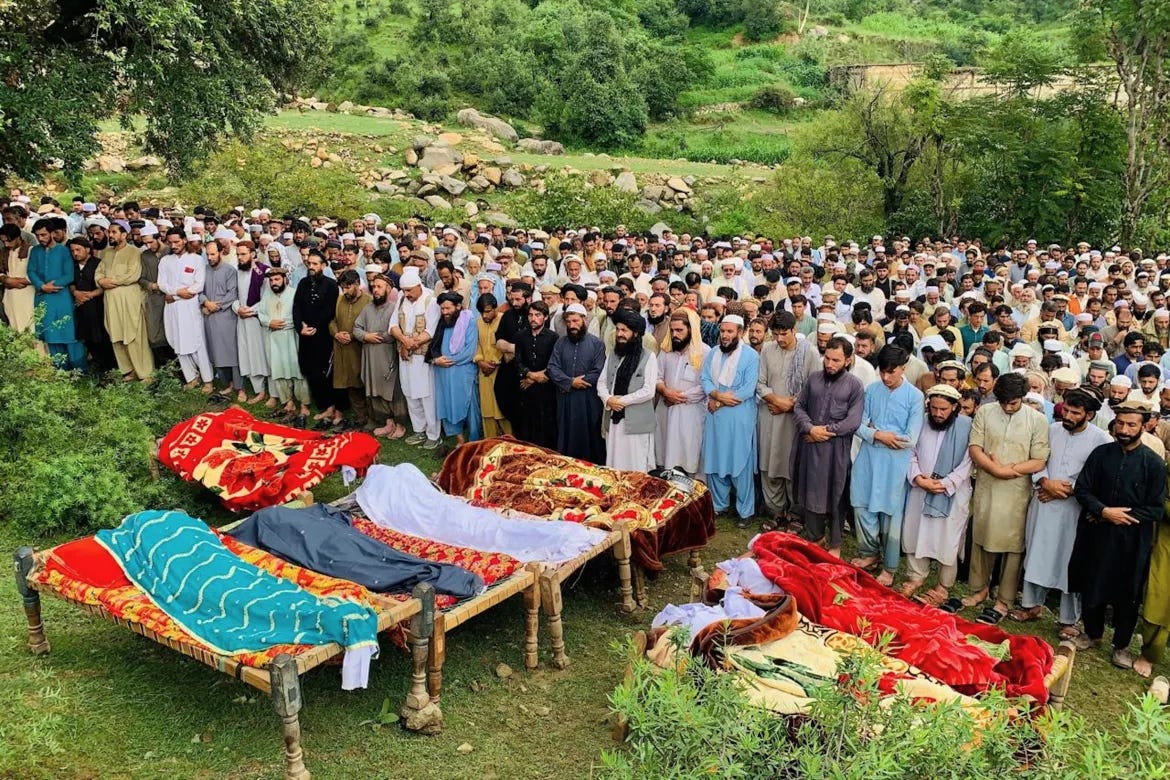How Pakistan's Floods Expose Seven Decades of Governance Rot
A Nation Drowns While Leaders Play Politics
The flash floods that devastated Khyber Pakhtunkhwa in August 2025 were supposed to be Pakistan's wake-up call. Instead, they became yet another testament to the country's pathological inability to govern itself. As rescue helicopters crashed in dense fog and bodies piled up in Buner district, the familiar theatre of Pakistani crisis management played out: delayed responses, bureaucratic finger-pointing, and compensation announcements that will likely disappear into the same administrative black holes that have swallowed development funds for decades.
Over 340 people died in what meteorologists called a rare cloudburst event, 150 millimeters of rainfall in a single hour on August 15. But the real tragedy wasn't the sudden deluge; it was Pakistan's predictably chaotic response to a crisis that exposed the hollow core of the country's governance structures.
While Khyber Pakhtunkhwa drowned, Sindh and Baluchistan continued their descent into severe drought. This isn't meteorological irony, it's the inevitable result of seven decades of water mismanagement so spectacular that Pakistan somehow manages to have floods and droughts simultaneously across a country smaller than Texas.
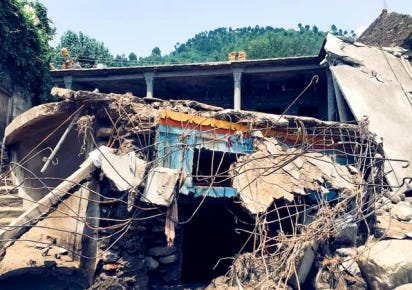
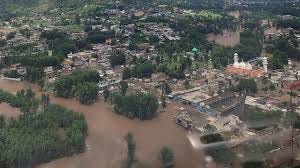
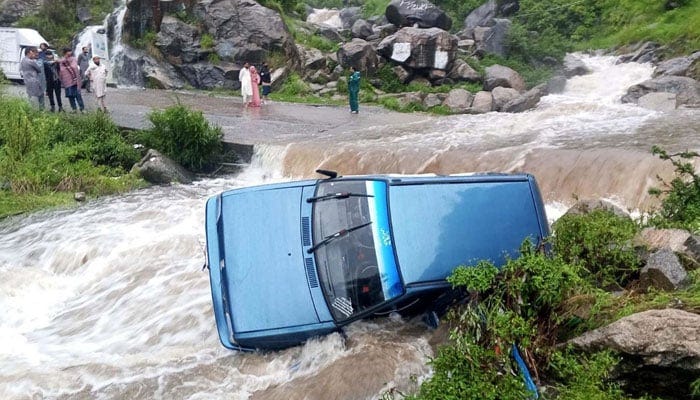
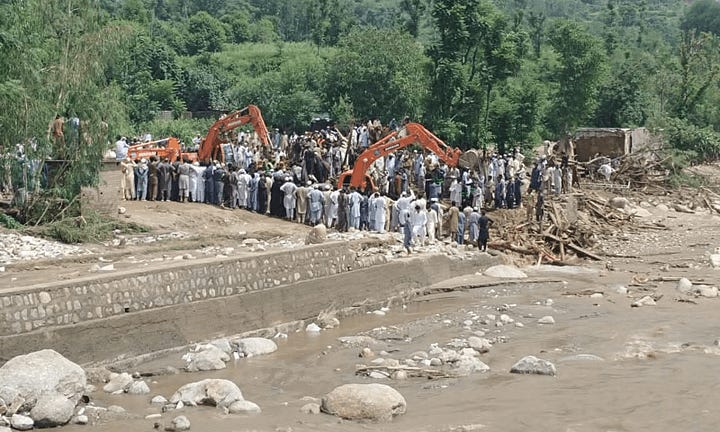
Pakistan's current political arrangement represents the most sophisticated deception yet attempted by its establishment. The Prime Minister announces flood relief packages while real decisions get made in GHQ Rawalpindi. The Army Chief allocates military rations for disaster relief, not the elected government. Provincial officials beg for federal helicopters that should be automatically deployed in national emergencies. Since 1947, Pakistan has endured 33 years of direct military rule interrupted by civilian governments operating under carefully constructed constraints. Today's hybrid system maintains the appearance of democracy while ensuring real power remains with unelected institutions that take no responsibility for governance failures.
When the floods hit, this arrangement collapsed into farce. Rescue operations were delayed 48 hours while bureaucrats shuffled approval papers between Peshawar and Islamabad. Provincial authorities couldn't deploy helicopters without federal clearance. Federal authorities demanded provincial cost-sharing agreements. People drowned while officials argued over jurisdiction and paperwork. The Mi-17 helicopter crash that killed five crew members perfectly encapsulates this dysfunction. The aircraft lacked modern navigation systems because military procurement prioritises weapons over rescue equipment. Those crew members died in dense fog that proper instruments could have navigated, but someone pocketed the avionics upgrade funds years ago.
Pakistan's water crisis reveals governance pathology in its purest form. The country possesses the world's largest contiguous irrigation system, 58,000 miles of canals built by British colonial administrators. Yet seven decades after independence, Pakistan cannot distribute water equitably across four provinces. The numbers expose systematic discrimination. Punjab consumes 37% of river water despite constituting only 23% of irrigated land. Baluchistan receives 3.7% of water resources while occupying 44% of national territory. Household water access tells an even starker story: Punjab 58%, Sindh 7%, Baluchistan 3%. While KP villagers waited for rescue boats, 18 districts in Baluchistan faced severe drought including Pishin, Chaghi, and Kharan. Sindh's Tharparkar, Umerkot, and Jacobabad suffer what meteorologists classify as "very severe drought hazard." Both Tarbela and Mangla dams sit at dead level with river flows at historic lows.
The Pakistan Meteorological Department confirmed in March 2025 that rainfall was 40% below normal from September 2024 to March 2025. Sindh faced a 62% deficit, Baluchistan 52%. Underground aquifers in Baluchistan drop 3.5 meters annually and will run dry within 15 years. Yet canal maintenance budgets routinely disappear into contractor kickbacks while politicians stage photo opportunities at dam inaugurations.
Pakistani officials reflexively cite "resource constraints" when explaining their inability to respond to disasters. This excuse rings hollow in a country that spends $11.3 billion annually on defense while allocating $47 million for disaster preparedness, less than the cost of a single F-16 fighter jet. The announced compensation of Rs 1.5 million per victim family ($5,300) follows established patterns of systematic theft. During the 2010 floods, Pakistan's Auditor General found 60% of international aid "unaccounted for." The 2022 floods affecting 33 million people attracted $1.6 billion in foreign assistance, yet victims still live in tents three years later. Recent scandals illustrate the scale of institutional corruption. The Upper Kohistan mega-corruption case exposed Rs 30-40 billion siphoned from provincial treasury accounts through forged cheques and phantom contractors. This represents more than the entire annual budget of the Provincial Disaster Management Authority, which operates on pocket change while generals purchase luxury vehicles worth more than complete emergency response programmes.
International donors enable this dysfunction through willful blindness. The World Bank approved $2.3 billion for flood resilience projects in 2023. Track those funds through Pakistani bureaucracy and watch them vanish into consultancy fees, feasibility studies, and cost overruns that somehow always benefit the same politically connected firms. Foreign governments know their aid gets stolen but continue disbursing to maintain diplomatic relationships. They're complicit in the deaths.
The human cost of institutional failure became tragically clear in remote Buner villages where residents received no advance warning despite meteorological forecasts predicting severe weather. Villagers report that mosque loudspeakers, traditionally used for emergency announcements, remained silent as the deluge approached. Officials defensively claimed the rainfall was "too sudden" to warn in time, yet the Pakistan Meteorological Department had issued heavy rain alerts days earlier. The real problem wasn't meteorological prediction but administrative paralysis. Warning systems exist on paper but collapse when actual warnings are needed because responsibility gets diffused across competing bureaucracies. This pattern repeats across every crisis. Emergency protocols gather dust in government offices while officials argue over authorization procedures. The same warning systems that failed Buner's flood victims will fail the next disaster because accountability mechanisms exist only for show.
Parliamentary oversight committees lack investigative powers and operate as patronage distribution centers. Supreme Court orders on disaster management get routinely ignored—witness the 2013 Karachi drainage ruling that authorities simply disregarded. Independent media faces advertising boycotts for criticizing response times. The system has perfected self-protection while abandoning public welfare.
Pakistan's establishment refuses to acknowledge the historical precedent staring them in the face. East Pakistan's 1970 cyclone killed 500,000 people. West Pakistan's response was identical to today's KP flood management: delayed relief, bureaucratic infighting, treating national emergencies as provincial administrative matters. Bengali victims watched Pakistani officials prioritize protocol over rescue operations. They saw resources allocated based on political proximity to power rather than humanitarian need. They experienced the same federal indifference that KP flood victims report today. That "provincial" disaster ended with East Pakistan becoming Bangladesh. The same alienation patterns emerge in KP today. When Islamabad treats national tragedies as provincial responsibilities, victims notice. Flood survivors express identical frustrations to Bengali cyclone victims fifty-five years ago: delayed federal response, inadequate resources, central government indifference. Rural constituencies that voted PTI now question why their representatives can't protect them from predictable disasters.
Political loyalty erodes with each preventable death, just as it did in East Pakistan. The establishment's response remains unchanged: blame provincial governments, announce compensation packages, wait for international attention to shift elsewhere. They learned nothing from losing half the country in 1971 because admitting failure would require acknowledging the system's fundamental illegitimacy.
Pakistan's budget priorities expose the regime's real values. Defense allocations consume 3.5% of GDP while disaster preparedness receives 0.1%. The military operates a fleet of F-16s and purchases Chinese submarines while rescue helicopters lack basic navigation equipment.
This isn't merely about spending priorities, it's about institutional identity. Pakistan's establishment defines national security through external threats while ignoring internal vulnerabilities that kill more citizens than any foreign enemy. Floods, droughts, and earthquakes claim thousands of lives annually, yet disaster management remains an afterthought in strategic planning. The KP floods killed more people in three days than terrorist attacks did in the previous year. Yet counterterrorism receives billions in funding while the Provincial Disaster Management Authority operates on the equivalent of pocket change. This represents a fundamental misunderstanding of where actual threats to Pakistani lives originate.
Emergency powers reveal the constitutional fraud in stark relief. During crises, elected officials become ceremonial while real authority flows through military channels. Provincial governments beg for federal resources they constitutionally deserve. The same officials who claim democratic legitimacy during peacetime abandon constitutional responsibilities when people actually need them. Disasters expose that Pakistan's democracy is performance art.
The spectacle of simultaneous floods and droughts across Pakistan represents governance failure so complete it defies rational explanation. While rescue teams searched for survivors in Buner's flood debris, farmers in neighboring provinces watched crops wither for lack of water.
Sindh experienced a 69.5% rainfall deficit during the same monsoon period that triggered KP's deadly floods. Baluchistan's drought conditions persisted for the fourth consecutive year while flash floods destroyed homes 300 kilometers away. This isn't meteorological coincidence, it's the predictable result of water policy so dysfunctional that Pakistan cannot manage abundance or scarcity. The country's irrigation infrastructure could theoretically address both problems through coordinated water management and flood control systems. Instead, provincial disputes rage over colonial-era water sharing agreements while actual distribution remains governed by political influence rather than technical need or constitutional entitlement.
Major dams operate at dead level not because Pakistan lacks water but because storage, distribution, and management systems reflect patronage networks rather than engineering requirements. Canal maintenance becomes a vehicle for kickbacks. Flood warning systems fail because responsibility gets diffused across competing bureaucracies. Drought relief arrives after crops have already died because approval processes prioritize administrative procedures over agricultural necessity.
Foreign governments and international organizations bear significant responsibility for enabling Pakistan's governance dysfunction through unconditional aid disbursement. Diplomatic relationships matter more than aid effectiveness, creating a system where Pakistani officials know they can steal relief funds without consequences. The World Bank's $2.3 billion flood resilience commitment represents the latest installment in this pattern. Previous projects disappeared into the same administrative black holes that consumed earthquake relief, drought assistance, and infrastructure development funds. Yet international donors continue disbursing because admitting aid failure would require acknowledging their complicity in Pakistani institutional decay. European Union flood assistance programs operate through the same compromised channels that diverted previous emergency funding. Chinese Belt and Road infrastructure projects enrich the same political networks that systematically loot domestic resources. American counterterrorism aid subsidizes military institutions that prioritize regime survival over public welfare.
This international enablement creates perverse incentives where Pakistani officials benefit more from crisis management than crisis prevention. Disasters attract foreign assistance that feeds patronage networks. Successful governance would eliminate these revenue streams, so institutional incentives favor perpetual crisis over effective administration.
Pakistan's establishment continues asserting democratic legitimacy while presiding over systematic governance collapse. Military leaders invoke "national security" to justify constitutional violations while citizens die from administrative negligence. Civilian politicians claim electoral mandates while operating under GHQ supervision. Bureaucrats cite "proper procedures" while emergency response systems fail catastrophically. These legitimacy claims ring hollow against mounting body counts. The KP floods represent the latest evidence that Pakistan's hybrid political system serves no public interest, not even the ruling elite's long-term survival. East Pakistan's secession cost military prestige and half the country's territory because they treated Bengali suffering as a provincial administrative matter. Baluchistan's insurgency stems from similar governmental neglect during past disasters.
Seven decades of evidence prove this system serves nobody's interests. The establishment that claims to protect Pakistan from external threats cannot protect Pakistani citizens from preventable disasters. Military institutions that demand constitutional deference abandon constitutional responsibilities during emergencies. Political parties that promise democratic governance deliver bureaucratic paralysis when governance actually matters.
The cycle repeats because the underlying mentality never changes. Pakistani officialdom treats peripheral regions as expendable, national emergencies as provincial responsibilities, and public welfare as an optional consideration. This institutional mindset destroyed East Pakistan and will eventually destroy what remains unless fundamental transformation occurs.
Pakistan's flood crisis will recede as international attention shifts elsewhere, but the governance pathologies that transform natural disasters into human catastrophes will persist unchanged. Cosmetic reforms cannot address institutional rot this deep. The problem isn't individual incompetence but systemic design that diffuses responsibility, rewards failure, and punishes accountability. The establishment continues treating national emergencies as provincial nuisances, exactly as they did with East Pakistan's cyclone. Until Pakistan's rulers stop viewing distant suffering as someone else's problem, natural disasters will continue becoming human catastrophes. The victims deserve systematic political transformation, not another round of hollow condolences and pilfered relief funds.
Pakistan possesses the human capital, natural resources, and institutional memory necessary for effective governance. What it lacks is a political settlement that prioritizes public welfare over elite capture. Until the establishment confronts this basic reality, floods will continue claiming lives that need not be lost, droughts will persist amid abundance, and governmental legitimacy will erode with each preventable tragedy. The choice facing Pakistan isn't between reform and revolution, it's between fundamental transformation and eventual disintegration. The floods in KP are a national tragedy, not a provincial one. How Pakistan responds will determine whether the country learns from its history or repeats the disasters that have defined its post-independence experience.
Seven decades of institutional failure cannot be reformed through adjustments and committee formations. Only comprehensive political transformation can break the cycle of crisis and neglect that has characterized Pakistan's existence since 1947. Whether Pakistan's establishment possesses the wisdom to pursue such transformation, or whether it will continue clinging to power structures that serve no one's interests, including their own, remains the defining question of Pakistan's political future.
The rains will come again. The question is whether Pakistan will be ready, or whether the next disaster will expose the same governance rot that turned August 2025's floods into yet another national tragedy that could have been prevented.



